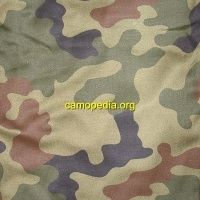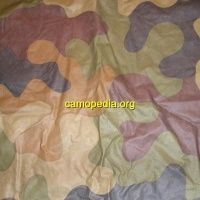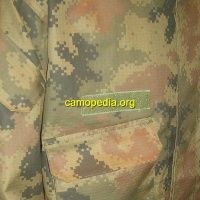Camouflage pattern PL woodland - Pantera pattern 93
Poland is a very interesting country in terms of camouflage patterns, as it has one of the most variable and fascinating histories of military camouflages in Europe.
During World War II, the "1st Independent Polish Parachute Brigade" joined/support the British "1st Airborne Division" during the legendary operation "Market Garden." This took place under the command of "Major-General Stanisław Sosabowski," whose brigade was mainly equipped with British uniforms and generally other English field equipment, including the hand-painted camouflage pattern known as "brushstroke".
This was a Denison smock for parachutists. Despite suffering heavy losses during this campaign, Polish parachute/air forces fought bravely and managed to significantly slow down many German units in the Netherlands, thus preventing the complete annihilation of the British "1st Airborne Division," which was unable to secure the Arnhem bridge and eventually had to retreat.
Despite the apparent and deep connection of these wartime allies, Poland ultimately ended up under Soviet control from 1944 onwards (1944 / 1990, it was the "Polish People's Republic"). It, therefore, logically did not use the Denison smock for parachutists afterwards. Interestingly, Polish armed forces were not significantly influenced by Russian camouflages. As it turns out, most Polish camouflage patterns are inspired by German World War II camouflages or are completely original models.
From about 1950 onwards and up to today, Poland has always supported the idea of using camouflage patterns in combat and for its troops. Note that this does not apply only to local special forces like the air force and special units but also to ordinary infantry conscripts. It was the first Warsaw Pact country to use the well-known "rain" camouflages. This design later became so popular that it was eventually used in about half of the states in its alliance. However, that was not the only thing – they also often experimented with unique camouflages, such as the famous "lizard skin" or "leopard skin." Eventually, Poland discarded (just like us) the communist shackles in 1989 and became a constitutional republic (officially from 1990 onwards). Now Poland enjoys full membership in NATO, the European Union, and the United Nations.
What camouflage patterns did Poland use from 1990 to today?
The first regular camouflage pattern that emerged as the first work of the new free Polish Republic was the "wz93 Pantera" type, sometimes also called the "presidential wooded landscape." It has similar shapes to the Polish experimental camouflage pattern "petals" from the 1970s, "wz93" has the following colors: black, reddish-brown, olive green, and amoebic shapes on a khaki background. Around 1993, this type became the standard-issued piece for all components/departments/sections of the Polish army.
It is signed by the Ministry of Defense (Ministerstwo Obrony Narodowej), as well as the "Ministry for National Affairs" and "Straż Graniczna" (regular border guards). Additionally, various hats, vests, tropical clothing, and other similar regular military equipment covered with this pattern were worn. This design was used both in the form of "heavy cotton" and as rip-stop fibers. In general, it can be said that this type of camouflage is still used in the Polish army, but it is expected to be soon completely replaced by modern pixel camouflage patterns.

At least one local variation appeared for this camouflage pattern for the Polish army on items issued to special Polish units. Specifically, it involves inflatable one-man boats printed with camouflage that resembles "wz93" but has shapes that are evidently closer on closer inspection to the "petals" type from the 1970s and, as can be seen, has been scaled up by at least 200%.

Around 2007-2008, Poland began testing two new pixel camouflage patterns as a potential replacement for the legendary camouflage "wz93" and "wz00". It is named the "digital panther" (in the original "cyfrowa Pantera") and is evidently a digital version of this traditional camouflage design. However, everything is still in the testing phase, so time will tell where history will lead. Let's not forget that the hot favorite for Poland remains the "Straż Graniczna" ("Border Guard"), which adopted a new camouflage pattern in 2015 based on Multicam, but there is one slight change – the color palette here is the same as the "wz93 Pantera" type. It is therefore possible that one will replace the other, both will be used, or nothing will happen because it proves ineffective.





























































































































